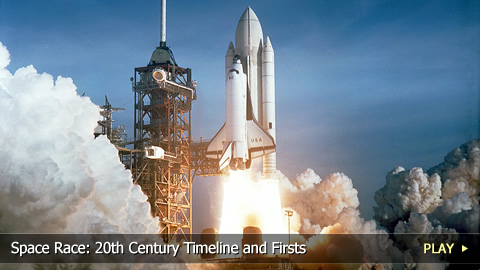Space Race: 20th Century Timeline and Firsts

Germany and the V-2 Rocket
German scientists followed suit by unveiling the V-2 rocket as early as World War II. This ballistic missile became the first object to penetrate space on October 3rd, 1942.
U.S.A. and Soviet Union in the Space Race
It wasn’t long before the Space Race between the USSR and the United States began. As part of the Sputnik 1 mission, the Soviet Union launched the first manmade satellite to reach Earth’s orbit on October 4th, 1957. Less than a month later, Laika the dog was the first animal to reach earth’s orbit alive via Sputnik 2.
NASA
The American government responded on July 29th, 1958 by creating the National Aeronautics and Space Administration, or NASA. The next year, the USSR’s Luna 2 became the first spacecraft to touch down on the Moon.
Humans in Space
The 1960s was an important period for space exploration: during that decade, humans entered space for the first time. With Vostok 1, cosmonaut Yuri Gagarin first visited outer space on April 12th, 1961.
Early NASA Missions
Within a month, the Mercury Redstone 3 mission reached space with NASA astronaut Alan Shepard on board. John Glenn became the first American to orbit the globe while piloting the Friendship 7 spacecraft on February 20th, 1962.
First Space Walk
The Space Race intensified when Soviet Aleksei Leonov performed the first space walk with the use of a tether after he exited the Vokshod 2 on March 18th, 1965
First Moon Walk
However, 1969 was the milestone year in space exploration: On July 21st, Neil Armstrong and Buzz Aldrin were the first humans to walk on the Moon during NASA’s Apollo 11 mission.
End of the Space Race
This urged the Soviets to accelerate their efforts over the next decade. They sent out two lunar rovers, and launched the first space station, Salyut 1, in 1971. But by mid-decade, the Space Race ended: the two superpowers united to conduct scientific experiments for the Apollo-Soyuz Test Project.
Space Shuttles and Stations
As the 1980s began, the Americans launched the inaugural space shuttle flight: Columbia took off April 12th, 1981. Two years later, after launching in 1972, the Pioneer 10 became the first probe to travel beyond the planets of our solar system. The Soviets contributed in 1986 by sending the Mir Space Station into low Earth orbit. Cosmonaut Valeri Polyakov spent a record-breaking fourteen months aboard that craft in 1995. Three years after that, the larger International Space Station launched as a satellite and research lab.
Hubble
Also during the 1990s, projects like the Hubble Space telescope revealed detailed images of the universe.
21st Century
As the new millennium began, progress didn’t slow: that was when the NEAR Shoemaker robotic space probe became the first to orbit and land on an asteroid.
Space Tourism
Space tourism became a reality in 2001 when millionaire and engineer Dennis Tito visited the ISS on the Expedition 2 spaceflight. Within three years, non-government funded human spaceflight began with SpaceshipOne. That spaceplane’s technology was later licensed to Richard Branson’s space tourism company, Virgin Galactic.
Mars
2004 also saw one of NASA’s two Mars rovers, Opportunity, discover the first meteorite on another celestial body. Humans began searching for Earth-like planets outside our solar system by launching the Kepler space observatory in 2006.
China
Though the Space Race was dominated by the U.S. and Russia, China got involved in the early 2000s by sending its first astronaut into space, and later by establishing a Lunar Exploration program.
Further Space Exploration
By 2011, NASA ended its Space Shuttle program by retiring the Discovery, Endeavour and Atlantis orbiters. That year, the U.S. also sent the Curiosity rover towards Mars. Meanwhile, Russia dispatched the biggest ever space telescope into orbit, the Spektr-R, in the hopes of learning more about outer space.
Future of Space Travel
Humans have long been fascinated with worlds beyond our own. Despite some grave tragedies, we will continue to marvel at the vast and limitless possibilities space exploration has to offer.
